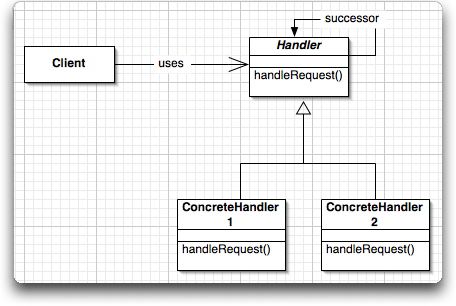Chain of Responsibility Pattern in Java
Handler defines the general structure of processor objects. ‘HandleRequest’ here is the abstract processor method. Handler also has a reference of its own type, which represents the next handler. For this a public ‘setNextHandler’ method should be defined and exactly the handler is an abstract class. ConcreteHandler define different representations of processors. At last, Client is responsible with creating required handlers (processors) and define a chain order between them.
Generally two diffent implementation may exist for this pattern. Difference is related with the ‘location of the chain routing business logic’. Chain routing business logic may be either in Handler abstract class or ConcreteHandler classes, or both of them. Sample of first two approaches will be given below:
1. ‘Handler’ has chain routing business logic:
public abstract class Processor {
protected Processor next;
protected int threshold;
public void setNextProcessor(Processor p) {
next = p;
}
public void process(String data, int value) {
if (value <= threshold) {
process(data);
}
if (next != null) {
next.message(data, threshold);
}
}
abstract protected void processData(String data);
}
public class ProcessorA extends Processor {
public ProcessorA (int threshold) {
this.threshold = threshold;
}
protected void processData(String data) {
System.out.println("Processing with A: " + data);
}
}
public class ProcessorB extends Processor {
public ProcessorB (int threshold) {
this.threshold = threshold;
}
protected void writeMessage(String data) {
System.err.println("Processing with B: " + data);
}
}
public class Client {
public static void main(String[] args) {
Processor p, p1, p2;
p1 = p = new ProcessorA(2);
p2 = new ProcessorB(1);
p1.setNextProcessor(p2);
// Handled by ProcessorA
p.process("data1", 2);
// Handled by ProcessorA and ProcessorB
p.process("data2", 1);
}
}2. ‘ConcreteHandler’s have chain routing business logic:
public abstract class Processor {
protected Processor next;
protected int threshold;
public void setNextProcessor(Processor p) {
next = p;
}
abstract protected void processData(String data);
}
public class ProcessorA extends Processor {
public ProcessorA (int threshold) {
this.threshold = threshold;
}
protected void processData(String data, int value) {
System.out.println("Processing with A: " + data);
if (value >= threshold && next != null) {
next.processData(data, value);
}
}
}
public class ProcessorB extends Processor {
public ProcessorB (int threshold) {
this.threshold = threshold;
}
protected void processData(String data, int value) {
System.out.println("Processing with B: " + data);
if (value >= threshold && next != null) {
next.processData(data, value);
}
}
}
public class Client {
public static void main(String[] args) {
Processor p, p1, p2;
p1 = p = new ProcessorA(2);
p2 = new ProcessorB(1);
p1.setNextProcessor(p2);
// Handled by ProcessorA
p.processData("data1", 1);
// Handled by ProcessorA and ProcessorB
p.processData("data2", 2);
}
}Reference: 2 Implementations of “Chain of Responsibility” Pattern with Java from our JCG partner Cagdas Basaraner at the CodeBuild blog.




The code has many problems, a call to message(..) in Processer exists, however, the method is not defined in the code. I think the coder meant to call process(..) instead.